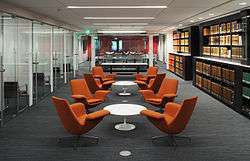Hill Museum & Manuscript Library
The Hill Museum & Manuscript Library (HMML) is a non-profit organization located at and sponsored by Saint John's Abbey and University in Collegeville, Minnesota. HMML’s mission is to identify, digitally photograph, catalog, and archive the contents of manuscripts belonging to threatened communities and to make the copies available to users around the world through online catalogs.[1]
 | |

| |
| Established | 1965 |
|---|---|
| Location | Collegeville, Minnesota |
| Coordinates | 45.5814567000°N 94.3924530000°W |
| Director | Columba Stewart |
| Website | www.hmml.org |
Since its founding in 1965, HMML has partnered with 540 libraries and archives to photograph more than 140,000 manuscript books dating from the ancient to early modern eras, totaling some 40 million handwritten pages. HMML serves three constituencies: communities or libraries with endangered manuscript collections; scholars who research manuscript and textual history; and the non-specialist general public interested in the transmission of human knowledge and artistic creativity in manuscript form.
In October 2015, HMML launched a new and comprehensive online resource for manuscript studies, vHMML or “Virtual HMML." at www.vhmml.org. A crucial extension of vHMML, vHMML Reading Room, went live at the end in the summer of 2016: https://www.vhmml.org/readingRoom/. vHMML Reading Room gives registered users access to HMML’s photographic manuscript archives from around the world. The initial collections available in vHMML Reading Room include representative samples of HMML’s diverse microfilm and digital resources, including images from Europe, Africa, the Middle East, and India. Highlights include manuscripts from Iraq and the famed Timbuktu manuscripts of Mali.
Over 6,000 complete manuscripts in thirty languages are now in vHMML Reading Room. vHMML Reading Room lets users search for manuscripts by country, repository, author, language, genre, date, features, city or even script. Even uncataloged collections will be hosted in vHMML Reading Room, lowering all barriers to scholarly access. Users can contribute cataloging metadata using a simple tool only a click away. Researchers can view a highly-zoomable single page or view the manuscript as a larger whole.
In addition to its manuscript collections, HMML holds works of art and rare printed books from the Middle Ages to the present [2] and is home to The Saint John's Bible, the first handwritten and illuminated Bible to have been commissioned by a Benedictine Abbey since the invention of the printing press in the 15th century.[3]
Since 2003, Columba Stewart, a monk of Saint John's Abbey, has served as HMML's executive director. HMML is located in the Alcuin Library, designed by Hungarian architect Marcel Breuer.
Operations
HMML serves as the preservation archive in the event that original manuscripts are destroyed, stolen, or otherwise lost. For each collection to be digitized, HMML signs a contract with the owners of the manuscripts, who then receive copies of the images and retain commercial and publication rights. Collections never leave the owners. On-site digitizing work is done by local technicians trained and paid by HMML. Administrative and funding activities are based at HMML’s location in Collegeville, Minnesota, while catalogers from both Collegeville as well as from several countries contribute to the creation of metadata for the recently-digitized manuscripts. In addition, HMML maintains a field office in Beirut, Lebanon.[4]
History
The Benedictine monks of Saint John's Abbey founded HMML in 1965 as a response to the loss of manuscripts and books in European libraries during two World Wars. Their plan was to create a microfilm collection of monastic manuscripts in Minnesota for safekeeping in the event that there would be another European war. Their work soon grew to include the microfilming of other manuscript collections throughout Europe and Ethiopia.[5] HMML expanded its focus in 2003 to include the preservation of manuscripts from other Eastern Christian traditions. Two factors drove this decision: the importance of Eastern Christian cultures to world history and the unstable conditions found in many of the historic regions of Eastern Christianity. With the launch of this project, HMML began using digital technology to preserve collections. In addition to digitizing Christian manuscripts, HMML has also digitized Islamic manuscripts collections from libraries in Harar, Ethiopia and the Old City of Jerusalem.[6] In 2014, HMML began working with SAVAMA-DCI, a malian N60 founded by Dr. Abdel Kader Haidara, to digitize over 200,000 historic documents and manuscripts that were smuggled out of Timbuktu in 2013 and kept safe from radical Islamist rebels who were destroying works they considered to be in conflict with strict Islamic teachings.[7] The copying of these Timbuktu Manuscripts is the largest project, by volume, of the HMML.[8]
Collections
HMML holds photographic copies of more than 140,000 manuscript books and other handwritten documents from hundreds of partner libraries spread across Europe, Africa, and Asia.[9] Manuscripts photographed before 2003 are in microfilm format (especially collections from western Europe, Mali, Ethiopia and Malta), while later collections have been photographed digitally (Middle East, India, and recent projects in Ethiopia and Europe). HMML also has about 10,000 rare books, as well as medieval and early modern manuscripts from Europe and Africa. The Arca Artium art collection at HMML includes approximately 6,000 works of art—chiefly printed works (woodcuts, engravings, linoleum cuts, lithographs, etc.) [10]
HMML provides bibliographic support for the microfilm and digital collections through its online database OLIVER and Vivarium. The printed book collections are cataloged in MnPALS and WorldCat. Vivarium provides access to research collections of related interest that reside at other institutions, including the Ethiopian Manuscript Imaging Project (EMIP). To support the use of its research collections, HMML maintains reference collections dedicated to manuscript studies, printing, art, and architecture.[11]
Digital and microfilm collections
The manuscript image collections at HMML are centered in four larger groupings, with several smaller collections.
- ▪ Materials from Austria, Germany and Switzerland
- ▪ Malta Collection: over 16,000 documentary records and manuscripts from the island of Malta and the Knights of Malta [12]
- ▪ Ethiopian Collection: over 8,000 manuscripts [13]
- ▪ Recent projects focus on Eastern Christian materials; Syriac, Arabic, and Armenian manuscripts in the Middle East and India [14]
Book and manuscript collections
Of the roughly 10,000 titles in HMML’s printed books collection, nearly half were printed before 1800, with 65 incunabula and over 800 sixteenth-century imprints. Topics covered include: theology, monasticism, biblical studies, patristics, homiletics, liturgical studies, and modern fine press books. Among these is a large collection of printed Bibles from the fifteenth to twentieth centuries. HMML also receives donated rare books and other gifts. The Special Collections at HMML hold a broad range of manuscripts in Latin, German, Italian, Spanish and French, as well as some in Gə’əz and Arabic.[15]
Exhibitions
HMML offers a year-round program of temporary exhibits of both selected manuscripts and rare books drawn from its collections.
Media
HMML has been featured in many international news stories in early 2017, including NPR's Here and Now,[16] The Atlantic: "The Monk Who Saved Manuscripts from ISIS,[17]" BBC World Service (story begins at 33:10 mark);[18] Australia's The World Today;[19] The Vatican's L'Obsservatore Romano;[20] PBS' Religion and Ethics Newsweekly;[21] Katholisch.de;[22] National Catholic Register, "A Minnesota Monk Takes on ISIS."[23]
Other articles include: "Faith's Archivists: Catholic monks in Minnesota are helping to save a trove of treasures in Mali,[24]" "Piece By Piece, Monks Scramble To Preserve Iraq's Christian History", "Preserving Words and Worlds", "Ancient Christians in India", "A Monk Saves Threatened Manuscripts Using Ultramodern Means", "Codices Decoded", "In the Footsteps of the Apostles", and "Monastery Works to Preserve Ancient Christian Texts", narrated by Fred de Sam Lazaro, who also produced and directed a 30-minute documentary on HMML entitled, "Saving the Sacred." [25]
References
- "HMML: Frequently Asked Questions" Archived 2014-03-13 at the Wayback Machine, Hill Museum & Manuscript Library.
- "Hill Museum & Manuscript Library (HMML)", College of Saint Benedict and Saint John's University.
- "A Bible for the Times", The Saint John's Bible.
- "A Monk Saves Threatened Manuscripts Using Ultramodern Means", The Chronicle, November 29, 2009.
- "Hill Museum & Manuscript Library", Institute of Museum & Library Services.
- "Monastery Works to Preserve Ancient Christian Texts", PBS News Hour, December 31, 2010.
- "Where HMML is working". HMML. Retrieved 16 February 2015.
- "Catholic monks in Minnesota are helping to save a trove of Islamic treasures in Mali". The Economist. 19 December 2015. Retrieved 20 December 2015.
- "Hill Museum & Manuscript Library", Arcadia.
- "HMML's Collections and Online Exhibits", Hill Museum & Manuscript Library.
- "HMML's Collections and Online Exhibits", Hill Museum & Manuscript Library.
- "The Malta Study Center", Hill Museum & Manuscript Library.
- "Ethiopia Study Center" Archived 2014-03-24 at the Wayback Machine, Hill Museum & Manuscript Library.
- "HMML's Preservation Work", Hill Museum & Manuscript Library.
- "Special Collections at HMML" Archived 2014-03-13 at the Wayback Machine, Hill Museum & Manuscript Library.
- "This Benedictine Monk Travels The World Helping Preserve Centuries-Old Manuscripts, Cultural Heritage". www.wbur.org. Retrieved 2017-04-25.
- Fagotto, Matteo. "The Monk Who Saves Manuscripts From ISIS". The Atlantic. Retrieved 2017-04-25.
- "The Fight for West Mosul, Newshour - BBC World Service". BBC. Retrieved 2017-04-25.
- "Benedictine monk races to preserve ancient Islamic manuscripts". ABC News. 2017-03-29. Retrieved 2017-04-25.
- "Salvare un patrimonio culturale". www.osservatoreromano.va. Retrieved 2017-04-25.
- "Extended Interview Fr. Columba Stewart OSB | January 27, 2017 | Religion & Ethics NewsWeekly | PBS". Religion & Ethics NewsWeekly. 2017-01-27. Retrieved 2017-04-25.
- "Der Manuskriptjäger". katholisch.de. Retrieved 2017-04-25.
- "A Minnesota Monk Takes on ISIS". National Catholic Register. Retrieved 2017-04-25.
- "Faith's archivists". The Economist. ISSN 0013-0613. Retrieved 2016-01-27.
- "HMML's Work to be Featured on Public Television Broadcast" Archived 2013-04-15 at Archive.today, Hill Museum & Manuscript Library, April 11, 2011.